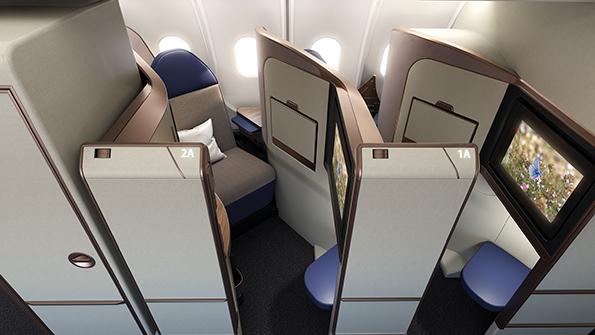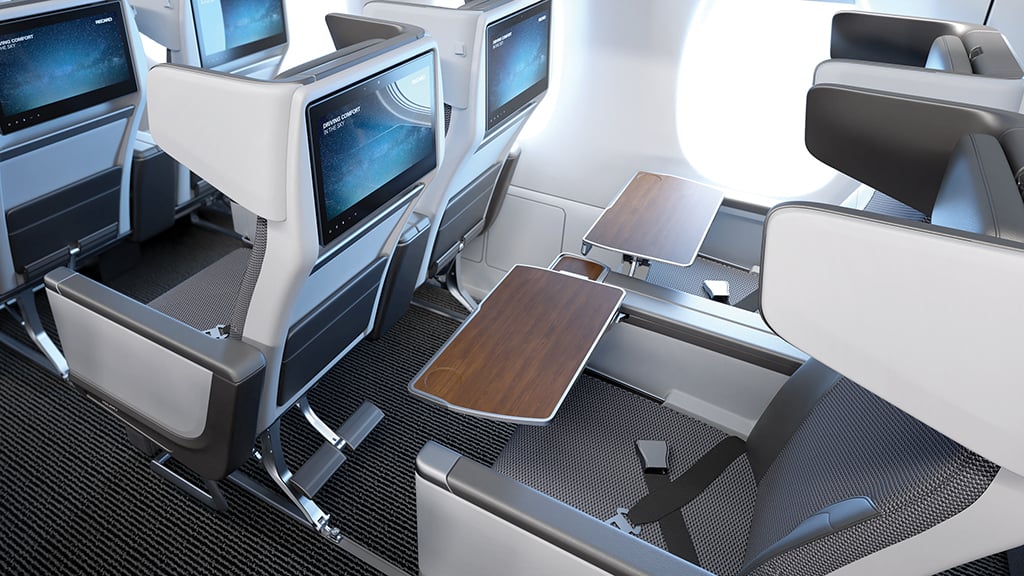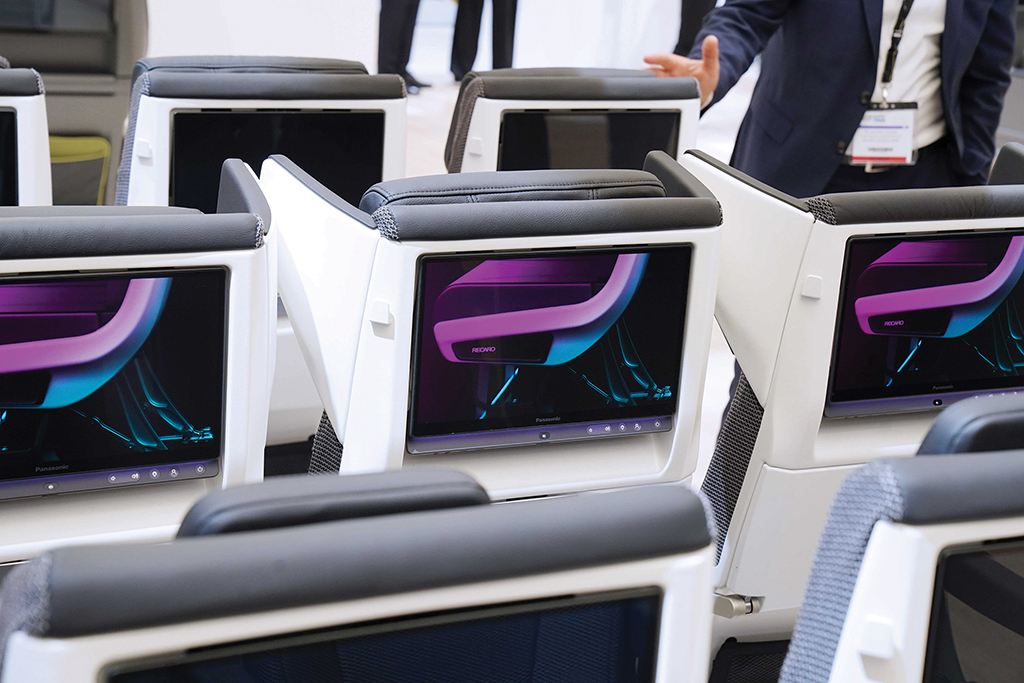Aircraft Interiors Upgrades Are In Demand, But Complicated

Collins debuted the Aurora lie-flat business suite for narrowbody aircraft in June.
The Aircraft Interiors Expo this year was the busiest and most eventful in memory, with new seats, improved inflight entertainment and an enormous shakeup of inflight connectivity with the conclusion of Viasat’s acquisition of Inmarsat immediately before the show in June.
Lukas Bucher, head of products and program for Lufthansa Technik’s special engineering services, summed it up best, telling Aviation Week: “There is a lot of catch-up after COVID. There is a big need in the industry for cabin upgrades, cabin retrofits and modernization.”
This requirement is not limited by geography or aircraft type or age. Numerous cabin upgrade programs to extend the useful passenger life of mature aircraft such as the Boeing 757 and 767 create a modern cabin almost indistinguishable from comparable aircraft coming off assembly lines today.
The key decision point, Bucher says, is “aircraft that will stay in operation more than 3-5 years, depending on the business case.”
He notes that “there is still a bit of densification activity,” but not as much as in 2018-19, because airlines are introducing new classes and new features within existing ones for revenue growth.
The addition of premium economy and new business-class seats in particular is driving a wider upgrade requirement, sometimes because older power supplies or legacy inflight entertainment (IFE) systems cannot support upgraded equipment.
Interacting Tensions
A variety of macroeconomic externalities have been affecting the interiors sector of the MRO industry in the first half of 2023. Many are likely to extend into the third quarter, with some easing in the fourth quarter.
A critical tension is the triangular relationship between three factors: pandemic-era delays to seat upgrades; delays in production (sometimes of engines for existing fleets) of several key aircraft lines including the Boeing 737 MAX, 777X and 787 and Airbus A320neo; and a supply chain still struggling to spin up to the higher-than-pre-pandemic production levels airframers would like while adding MRO-driven production to their lines.
Ongoing supply chain issues are the biggest headache for the airframers and their MRO service units, says Tim McVea, Airbus’ deputy head of marketing for aircraft modifications and sustainability services.

“Lead times have increased significantly post-COVID, particularly for premium seats and customized cabin elements. We also see a general increase in costs across the supply base,”s McVea says, noting that reducing lead times requires “supplier support and longer-term planning regarding project delivery dates.”
Additional project management resources are being deployed both down the chain to suppliers and up the chain to customers, with renewed interest in assistance for airlines and lessors around project guidance, including layout optimization and timeframe-suitable trade-offs.
Nonetheless, “first and foremost, parts availability and the supply chain continue to be a major focus for MRO events,” says Sean Lyons, Collins Aerospace’s vice president for business development “Component availability is improving but still a constraint.”
These supply chain schedules also are subject to the availability of qualified staff. As elsewhere in the aviation industry, the staffing crunch is having a big impact.
“Like many other companies, maintaining an agile supply chain is a top priority for our team,” Recaro Aircraft Seating CEO Mark Hiller says. “Limited capacities can make this global situation more complex. We are currently balancing a ramp-up with a resource shortage. This is a hurdle for us to manage future projects effectively, so we are investing heavily in these elements to support our long-term strategy.”
For larger jobs, especially those requiring complicated certification work, airlines (more than lessors, as a rule) are increasingly turning to airframers’ services businesses to manage and undertake the work in-house. This is especially attractive for consolidating commonality across fleets and subfleets.
Airbus’ McVea says the OEM “has seen a big increase in the number of cross-program projects where airlines are looking at fleet harmonization with new aircraft,” such as mixing the A350 with the A330ceo and A330neo. “Often the decision is driven by the latest passenger experience trends, like selection of new premium seats or IFE, and extended to in-service aircraft.”
Innovations created by the airframers themselves—whether as retrofits or offered as linefit with retrofit options—are also driving their services businesses. Airbus’ Smart-Lav widebody lavatory and Space-Flex combined narrowbody galley-lavatory are two useful examples.
Refurb or Replace?
One of the big questions in MRO of interiors is whether to maintain, repair or overhaul elements of the cabin. There are many facets to this question, including what is driving the work. Is it seating? IFE? Another aspect of the cabin? What is the physical state of the element to be refurbished or replaced?
Airlines are just starting to make these interior reconfigurations, such as replacing fully flat beds with direct aisle access. Finnair recently replaced its Airbus A350 Safran Cirrus outward-facing herringbone seats with the new Collins Aerospace AirLounge sofa-style product. This was part of a full cabin refresh, including the addition of a premium-economy cabin.
But in some cases, even airframer-performed MRO is moving toward the refurbishment market.

“Refurbishment has certainly increased on Airbus-led projects, partly driven by customer demand but also to address supply chain challenges for projects where lead-time is critical,” McVea says. “We now have a dedicated team to source used parts for refurbishment wherever possible, and it’s becoming a standard practice to check where used refurb or used parts can make sense. This has advantages for lead times, cost reduction and waste reduction—and all are requested by customers today.”
Within the cabin—which Airbus Vice President for Cabin Marketing Ingo Wuggetzer noted at the expo accounts for some 20% of an airliner’s total lifetime emissions footprint—refurbishment only makes sense if there is not a weight impact on the aircraft.
“We see more and more interest from customers to look at a complete life-cycle approach,” McVea notes. “Waste reduction is certainly a factor but needs to be fully put into perspective—refurbishment of old seats versus installation of lightweight slimline seats might save waste, but we see more focus today on fuel-burn reduction and CO2 from operations.”
Overall, the specific environmental performance of one MRO provider’s actual work practices versus another’s seems to be a secondary factor. Adherence to increasingly strict environmental standards of work is now a given, and those requirements will continue to grow, but if one MRO can deliver a lighter-weight solution than another, then cutting the aircraft’s cabin weight is the option with the greatest environtmental impact.
“In our experience, when you replace an older, heavier seat with a new, lighter product, this has a greater impact on reducing carbon emissions than installing a refurbished seat,” Recaro’s Hiller says. “This could definitely shift, as there is a lot of focus on extending the life cycle of cabin products.” While light weight is a big factor, durability is as well. “Price-sensitive airlines are focusing on a longer seat lifetime, 20-plus years,” he adds.
Recaro recently inaugurated a full in-house seat MRO operation at its Schwabisch Hall base near Stuttgart, Germany, refurbishing seats and even transitioning them between operators. At the same time, its light-customization Sprint, Swift and Smart economy-class seats, mostly produced at its factory in the western Polish city of Swiebodzin, have enjoyed strong success.
The drivers here are both lessors swapping operators and airlines needing seats urgently, whether for secondhand aircraft or factory-fresh deliveries that for some reason (such as white tails and production sequence swaps) cannot be delivered with the carrier’s primary product.
“We are seeing airlines keeping aircraft in service longer than ever, and there are aircraft transitions between operators happening frequently,” says Tom Eskola, vice president of Panasonic Technical Services. “In these situations, airlines can actually achieve a significant discount on long-term maintenance of onboard [inflight entertainment and connectivity] systems by engaging in a contract for material management, fixed-price repair or even a turnkey maintenance proposal.”
Sometimes the primary driver is replacement cost. IFE screens have historically lagged 5-8 years behind consumer technology, although this gap is shortening in terms of hardware, software and how the two interact. This means that maintaining systems in an operational context has gained substantial complexity—even before the increased turnover of operators driven by the pandemic.
“The main drivers for both refurb and replace are availability and short lead-times,” Recaro’s Hiller says. “It’s contingent on the needs of the airline and product strategy. If they are happy with the product as is, a refurb makes more sense. On the flip side, if the airline is interested in more major changes, replacement is the better option.”
Hiller says most airlines choose the seat replacement option, although refurbishment or a combination of refurbishment/modification are also options.




